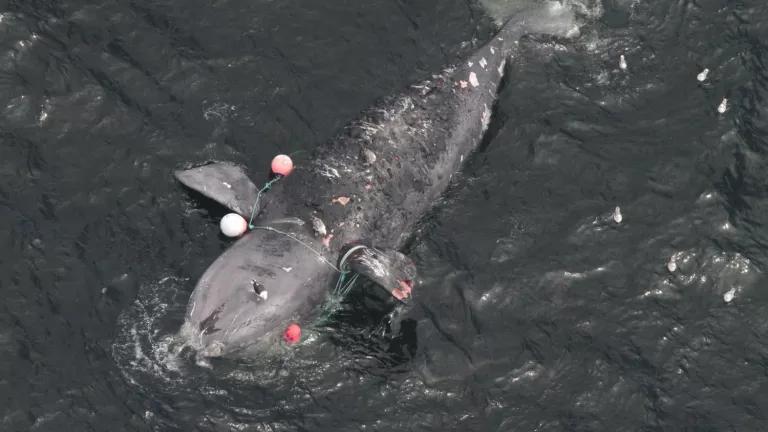
We need to make all fishing safe for whales. This message rang loud and clear during two meetings in Portland, Maine, this week that brought together the community of scientists, engineers, environmental groups, and fishermen working to protect North Atlantic right whales and advance ropeless (or “buoyless”) fishing gear.
The latest science shows that the North Atlantic right whale is continuing to decline towards extinction and the number and severity of entanglements is worsening. Following the ten documented deaths and seven new calves born over the past year, there are now estimated to be around 400 right whales remaining. Their number may even be in the 300s.
As one attendee noted: “there are more people at this meeting than there are right whales.”
More than 86 percent of surviving North Atlantic right whales now bear scars of entanglement. Of 486 unique entanglement events examined between 2010-2018, 35 percent of those were categorized as “moderate” or “severe” meaning they will significantly diminish the whales’ health and chance of survival.
Disentanglement efforts are not a long-term solution and pose significant safety risks to the people involved. Fishery area closures, while an important and effective tool to reduce entanglements in certain high-risk areas, are also not a long-term solution as whales still become entangled outside of closures, and fishermen may experience damaging economic impacts.
This leads us to the critical question: How do we make all fishing safe for whales?
The answer: Ropeless fishing systems.
Support for ropeless fishing has progressed in leaps and bounds over the last year. Six fishermen presented their experiences testing ropeless fishing systems during the meeting. Their view was that the technology does fundamentally work, and now efforts need to focus on refining it to meet the needs of individual fisheries and developing the systems required to support its commercial use.
The main incentive fishermen expressed for participating in the testing was to regain access to existing or foreseeable fishing closures established to protect whales from entanglement. NOAA Fisheries showed their support for this approach, expressing that “closed” areas would essentially become “buoyless” areas.
To advance ropeless fishing systems to the point of commercially viability, we need to address two key challenges:
- Large-scale experimental fisheries will be needed to tailor ropeless fishing systems for individual fisheries and evaluate their readiness for commercial use. During this testing phase, data needs to be collected in standardized way, so the effectiveness of the systems can be objectively evaluated.
- Gear location methods to track the position of ropeless fishing gear on the seabed so that fishermen, regulators, and enforcement agencies can ‘see’ where the gear is located need substantial development. A unified system is needed that will work across different ropeless technologies and across different fisheries. It is also an open question as to who should be responsible for leading the development of such an integrated gear location system.
Ultimately, the speed at which ropeless fishing can be advanced will depend on funding. Progress is mainly resource-limited rather than technology-limited at this point. While several grant programs are available to fund small pieces of the necessary work, large-scale experimental fisheries and development of an integrated gear location system will require a multi-million dollar investment.
Yet, as one speaker noted, “we are looking to evolve a fishery.” In that context, the funding required to save our precious right whales from extinction and keep fishermen on the water could be considered relatively economical. We just need to get creative!
TAKE ACTION NOW to help increase funding for innovative solutions to end entanglements of endangered North Atlantic right whales.


